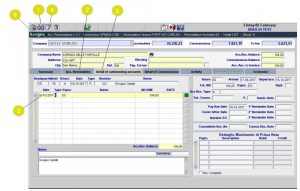
With your deposit slip in hand, you can record a bank deposit and combine the payments in QuickBooks. All payments in the Undeposited Funds account automatically appear in the Bank Deposit window. In the above scenarios, you’ll likely find the transaction in the undeposited funds account. So be sure to double-check that you properly complete the bank reconciliation to clear the balance. If you receive two payments, a check for $50 and another for $100, and deposit those checks, your bank will report a deposit of $150. If you didn’t use Undeposited Funds, your ledger will show the individual checks, and reconciling your bank account could quickly become a nightmare.
Your customer has given you a payment for goods purchased or services rendered. If your customer is paying an invoice you have entered into QuickBooks Online and sent to them, you will want to record the payment using the Receive Payments option. Let’s say your customer sent you a check for services rendered. You received the check on the last day of the year, which happened to be a Saturday. If your bank records a single payment as its own deposit, you don’t need to combine it with others in QuickBooks.
- This is different from petty cash or your cash register till, which is cash you have on hand but don’t intend to deposit.
- QuickBooks Online has a special account specifically for these funds in transit.
- Learn how to use the Undeposited Funds account in QuickBooks Desktop.
- As you can see above, my reconcile screen shows one deposit for those three payments and makes it easy for me to match with my bank.
Learn how to use the Undeposited Funds account in QuickBooks Desktop. Learn how to use the Undeposited Funds account in QuickBooks accountant for freelancers Online. Looking for intuitive and simple workflows to satisfy your accounting needs? FreshBooks is made with small business owners and freelancers in mind. Many users have found this account tedious because it’s not very intuitive to untrained users. For a tutorial on how to use this account, we have put together a step-by-step instruction guide.
Payments processed with QuickBooks Payments:

The most important reason for using Undeposited Funds when receiving payments and making deposits is to ensure that your bank statements will match your QuickBooks bank account ledger. As you can see above, my reconcile screen shows one deposit for those three payments and makes it easy for me to match with my bank. This process also applies if you collect checks and cash from your customers and then like to make one deposit into the bank. No more adding things up and hoping you get the right amount. Undeposited funds are like a big bag of money or cash drawer that you would keep your checks and cash payments in until you deposit them at the bank.
How Do I Avoid Undeposited Funds in Quickbooks?
Head over to the plus sign icon + and select Receive Payment. Choose your customer from the drop-down menu and their open invoice will automatically show up on the list. Choose your payment method and verify the amount received. At the bottom of the screen, you will see a section titled “Add New Deposits.” This is a place for nontraditional checks that come in from outside places and are not necessarily payments received from customers. gross profit operating profi vs net income To begin, you need to ensure that the undeposited funds account is enabled in QuickBooks.
Small Business
If you have QuickBooks Payments, it will also use this account. You may see credit charges coming through from Payments, so the amount may not always be $0, but that is the goal. Next, we repeated the process for Bill’s Windsurf Shop to show how undeposited funds works with multiple payments. First, find your customer with an open invoice in QuickBooks. Under the Action tab, click “Receive Payment.” Notice that when you go to receive the payment, QuickBooks will automatically deposit this to undeposited funds, shown below. In the video above, we used a QuickBooks Online sandbox account to recreate common transactions that would use undeposited funds.
If you process invoice payments through QuickBooks Payments for Desktop, QuickBooks takes care of everything for you. You don’t need to combine payments or move them to an account. Here’s how to put payments into your Undeposited Funds account before you combine them.
We provide a vast range of QuickBooks services to suit all your needs. Chances are you will occasionally receive payments from multiple customers and batch those into one deposit. Posting these payments to the Undeposited Funds account will allow you to correctly record the deposit in QuickBooks Online, making reconciling your bank account easier. Sometimes funds are “in transit” for less than a day, as when a customer pays you with cash or a check and you take the money to your bank at the end of the day. Other times, funds might be in transit for several days. This is most common when you batch your deposits — only going to the bank once or twice a week — or when you accept a credit card payment and it takes a day or two for the funds to clear your bank account.
This small business bookkeeping basics account is created automatically as part of your business’s chart of accounts and cannot be deleted. If you try to do so, QuickBooks Online will just create a new Undeposited Funds account for you. You’ll also notice that when you click on the deposit, it expands and you can choose to edit.
